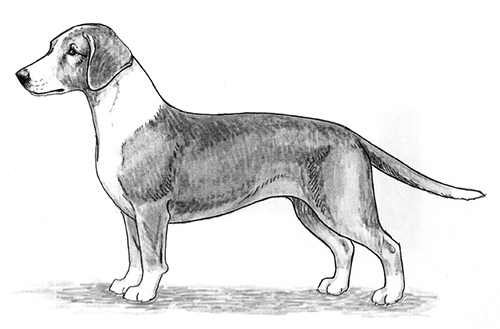Westphalian Dachsbracke
Scenthound Group
The goals and purposes of this breed standard include: to furnish guidelines for breeders who wish to maintain the quality of their breed and to improve it; to advance this breed to a state of similarity throughout the world; and to act as a guide for judges.
Breeders and judges have the responsibility to avoid any conditions or exaggerations that are detrimental to the health, welfare, essence and soundness of this breed, and must take the responsibility to see that these are not perpetuated.
Any departure from the following should be considered a fault, and the seriousness with which the fault should be regarded should be in exact proportion to its degree and its effect upon the health and welfare of the dog and on the dog’s ability to perform its traditional work.
History
The Westphalian Dachsbracke is a small scenthound that originated in Germany.
The Westphalian Dachsbracke was recognized by the United Kennel Club in 2006.
General Appearance
The Westphalian Dachsbracke is the short-legged variety of the German Hound. It is moderately long, and sturdily built.
Head
The head is long and narrow.
SKULL
The occiput protrudes only slightly. The stop is minimal.
MUZZLE
The muzzle is long, with a slightly arched bridge. The lips are moderately overlapping.
TEETH
The Westphalian Dachsbracke has a complete set of evenly spaced, white teeth meeting in a level or scissors bite.
NOSE
The nose has fairly dark pigment, but there is a lighter, almost flesh colored strip in the center.
EYES
The eyes are dark and clear, with a friendly expression.
EARS
Medium length, broad and close fitting, with rounded tips.
Neck
Moderately long and fairly thick, with some loose skin but no dewlap.
Forequarters
Well developed, heavy boned, clean and sinewy.
FORELEGS
The legs are straight, with close fitting elbows.
Body
The chest is not as developed as in the Dachshund. It is strongly supported by the forelegs, and should not be let down too much between them. The ribcage is long. The back is slightly arched and has a slight dip behind the shoulders. The loin is broad and strongly developed. The croup is sloping. There is a slight tuck up.
Hindquarters
The hindquarters are straighter than in most other breeds.
HIND LEGS
The hind legs are strongly developed, and have pronounced muscles.
Feet
The feet are sturdy, with tight, short toes.
Tail
The tail is set on relatively high, and is very thick at the root. It is carried in saber fashion, and has a bristly brush on the underside.
Coat
The entire body is covered with a dense, coarse coat. It is short on the head, ears and lower legs, longer on the back, neck and underside of the tail.
Color
Red to yellow, with a black saddle or mantle, and white markings on the head, neck, chest, legs and tip of tail. Bi-color dogs are undesirable, as are dogs with black markings on the head.
Fault: Chocolate brown.
Height
Height at the withers is 12 to 15 inches.
Disqualifications
(A dog with a Disqualification must not be considered for placement in a conformation event, and must be reported to UKC.)
Unilateral or bilateral cryptorchid.
Viciousness or extreme shyness.
Albinism.

Looking for a Dog?
Find a dog that will fit your family.
Note: The breeders on this list are not endorsed by UKC.
©Copyright 2006, United Kennel Club
